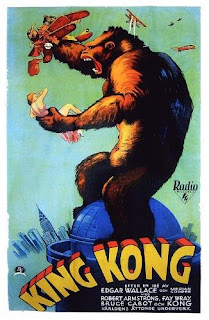King Kong (1933) Film Review
King Kong can be linked to multiple genres such as adventure, horror and science fiction. It was directed and produced by Merian C. Cooper and Ernest B. Shoesack (Figure 1 IMDb, 2019) and was written by Ruth Rose and James Ashmore Creelman. It was fully released in the USA by the 7th of April 1933 and then 10 days later released in the UK on the 17th of April 1933.
 |
| Figure 1 |
While travelling Ann meets Jack Driscoll who is the first mate and they are instantly attracted to each other. After weeks of travelling, they arrive at an island surrounded by fog with the sound of drumming in the distance. When they got onto the island, they are met with the natives who are about to hand over a girl as a sacrifice. The chief spots them and approaches, he takes interest in Ann due to her appearance. Carl interjects and says they will return tomorrow to get better acquainted. That evening the natives capture Ann to use her as a sacrifice instead. Kong comes to take Ann, while Carl, Jack and some of the other men go after them to save her. Jack eventually saves Ann and they escape back to the village with Kong chasing after them. Carl throws a gas bomb at Kong and it knocks him out.
Back at New York Carl, Jack and Ann present Kong to an audience, Kong gets angry at the flashing from the camera and escapes. During his rampage he captures Ann again and carries her to the top of the Empire State Building. The military send out many planes and while attacking he gets shot multiple times and eventually falls to his death. Lastly Carl says “It wasn’t the airplanes; it was the beauty that killed the beast.” Which is the most popular quote from the film.
Within this film there’s two different environments (as shown in the figures 2 and 3), these contrast from each other as one has more of a natural background from the other. The city comes across brighter due to all of the artificial lighting, which can link to how Kong lashed out. Alongside, all of the different sounds and the crowds of people.
 |
| Figure 2 |
 |
| Figure 3 |
Another point is that this storyline can be linked to modern folk tales. “The story, like Frankenstein and Dracula, has taken on the significance of a modern folk tale” (rotten tomatoes,2019) This is because it is noticeable that there are morals within the story, one being ‘when we try to force nature into serving our needs, nature turn against us.’ Today this could be linked to global warming as over a multitude of years we have taken advantage of nature and now it is fighting back. The conclusion that can be drawn from this is that even today King Kong is still a significant film and will be for many years in the future.
Bibliography
Rotten Tomatoes. (2019). King Kong (1933). [online] Available at: https://www.rottentomatoes.com/m/1011615_king_kong [Accessed 15 Oct. 2019].
Theguardian.com. (2019). King Kong | Film | The Guardian. [online] Available at: https://www.theguardian.com/film/movie/36134/king.kong-review [Accessed 15 Oct. 2019].
Illustration List
Figure 1 IMDb. (2019). King Kong (1933). [online] Available at: https://www.imdb.com/title/tt0024216/mediaviewer/rm3978610176 [Accessed 15 Oct. 2019].
Figure 2 IMDb. (2019). King Kong (1933). [online] Available at: https://www.imdb.com/title/tt0024216/mediaviewer/rm3017684480 [Accessed 16 Oct. 2019].
Figure 3 IMDb. (2019). King Kong (1933). [online] Available at: https://www.imdb.com/title/tt0024216/mediaviewer/rm3678574592 [Accessed 16 Oct. 2019].
Comments
Post a Comment